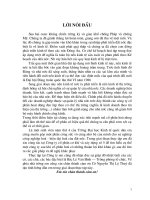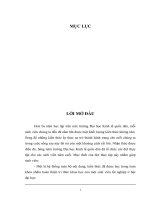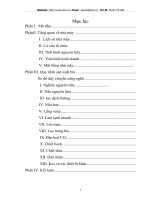bài giảng tổng quan về nhà máy lọc dầu
Bạn đang xem bản rút gọn của tài liệu. Xem và tải ngay bản đầy đủ của tài liệu tại đây (1.79 MB, 25 trang )
1
2
ThS. Nguyễn Văn Toàn
ThS. Nguyễn Văn Toàn
ThS. Nguyễn Văn Toàn
ThS. Nguyễn Văn Toàn
ThS. Nguyễn Văn Toàn
Type Characteristics
Paraffinic Paraffinic crude contains paraffin hydrocarbon as a
major component, which has low octane number and
high cetane number. High paraffin wax and less
asphalt is included.
Naphthenic Naphthenic crude contains naphthenic hydrocarbon as
a major component, which has high octane number of
gasoline and low cetane number of diesel. High
quantily of asphalt is included.
Mixture Most of the crude oil produced in the wold belongs to
this category. Crude oil from Middle East has mixture
crude.
Type of Crude Oil
ThS. Nguyễn Văn Toàn
Classification by API Density
The American Petroleum Insitute (API) gravity is an American
standard measurement of petroleum density. High value of API
density stands for ligh petroleum.
API Density > 34 34 ~ 30 < 30
Class Ligh crude Medium crude Heavy crude
ThS. Nguyễn Văn Toàn
Classification by Sulfur Content
Sulfur compound is only harmful to human, but also
accelerates corrosion of production facility during refinery
process.
Also it has mal-effect on catalyst in the reactors and acts as a
major air pollutant when exhausted after combustion.
Sulfur Content < 1 Low sulfur
Sulfur Content < 1 High sulfur
ThS. Nguyễn Văn Toàn
Do chất lượng quy cách dầu thô có thể thay đổi nhiều, tùy
theo mỏ khai thác, người ta quy ước một số loại dầu thô
làm chuẩn so sánh để tiện mua bán trao đổi, trên cơ sở có
tỷ lệ, thành phần tương đương, hoặc quy về tương đương.
Các loại đó là:
•
Brent.
•
OPEC Basket.
•
WTI.
•
Dubai Crude.
Classification
ThS. Nguyễn Văn Toàn
Brent:
được chia thành 4 loại nhỏ là
Brent Crude
,
Brent
sweet light crude
,
Oseberg
và
Forties
. Trong đó
Brent Crude
là loại từ biển Bắc. Tên này là thuật ngữ do
Shell đặt, dựa trên chữ tắt của tên các tầng địa chất
Broom, Rannoch, Etive, Ness và Tarbert
. Brent được dùng
làm chuẩn cơ sở trên tòan cầu.
Đặc tính
: 0.37% lưu hùynh, API 38.06 (tỷ trọng khỏang
0.835). Dễ chưng cất cho các sản phẩm nhẹ như xăng. Khi
đắt hàng, dầu Brent còn có thể được xuất từ các nhà máy
lọc dầu ở Mỹ hoặc Địa Trung Hải. Thường cao giá hơn
OPEC basket một vài USD.
Classification
ThS. Nguyễn Văn Toàn
OPEC Basket: thuật ngữ này do tổ chức các nước sản
xuất dầu mỏ (OPEC) xây dựng trên cơ sở bình quân có
trọng số của giá dầu do các nước thành viên sản xuất:
- Saharan Blend (Algeria)
- Minas (Indonesia)
- Iran Heavy (Islamic Republic of Iran)
- Basra Light (Iraq)
- Kuwait Export (Kuwait)
- Es Sider (Libya)
- Bonny Light (Nigeria)
- Qatar Marine (Qatar)
- Arab Light (Saudi Arabia)
- Murban (UAE)
- BCF 17 (Venezuela)
Classification
ThS. Nguyễn Văn Toàn
WTI: viết tắt từ West Texas Intermediate, dầu nhẹ và
ngọt, sử dụng ở Mỹ để làm cơ sở tính giá; loại dầu này
cho phép sản xuất các loại xăng và dầu diesel ít lưu
hùynh.
Đặc tính:
hàm lượng lưu hùynh khỏang 0.24%, cao cấp
hơn Brent. Thường cao giá hơn Brent khỏang một vài
USD.
Dubai Crude: là loại được sản xuất từ tiểu vương quốc
Dubai thuộc UAE. Còn được gọi là Fateh. Thường dùng ở
khu vực Trung Đông.
Đặc tính:
2% lưu hùynh, API 31 (tỷ trọng khỏang 0.871).
Classification
ThS. Nguyễn Văn Toàn
Petroleum industry
Large investment
Standardized technology
Sensitive to market fluctuation
Uniform and standardized product quality → easy for international trade
Largely depends on the cost of crude oil
Refinery
Process
Petrochemical
Process
Polymerization
Process
Crude
Oil
Naphtha
Naphtha
Olefin Process
Aromatic Process
Polyethylene Process
Polypropylene Process
ThS. Nguyễn Văn Toàn
15
POWER
PLANT
AUXILIARY
TECHNOLOGY
CRUDE OIL
STORAGE
TANK
PRODUCTS
STORAGE
TANK
CRUDE OIL
IMPORT
CRUDE OIL
EXPORT
EXPLOITATION
OF OIL WELL
ThS. Nguyễn Văn Toàn
ThS. Nguyễn Văn Toàn
ThS. Nguyễn Văn Toàn
ThS. Nguyễn Văn Toàn
19
ThS. Nguyễn Văn Toàn
20
Liquified Petroleum Gas (LPG). LPG, which consists
principally of propane anh butane, is produced for use as fuel
and is an intermediate material in the manufacture of
petrochemicals.
Gasoline: the most important refinery product. The important
qualities for gasoline are octane number (antiknock), volatility
(starting and vapor lock), and vapor pressure (environmental
control).
Kerosene: kerosene is a refined middle-distillate petroleum
product that fines considerable use as a jet fuel and around the
word in cooking and space heating. Kerosene, with less-critical
specifications, is used for lighting, heating, solvents, and
blending into diesel fuel.
ThS. Nguyễn Văn Toàn
21
Distillate Fuels: diesel fuels and domestic heating oils have
boiling ranges of about 400-700
0
F.
Residual Fuels: many marine vessels, power plants,
commercial building and industrial facilities use residual fuels or
combinations of residual and distillate fuels for heating and
processing.
Coke and Asphalt: coke is almost pure carbon with a variety
of uses from electrodes to charcoal briquets. Asphalt, used for
roads and roofing materials.
Solvents. These include benzen, tolune and xylene.
ThS. Nguyễn Văn Toàn
22
Petrochemicals. Ethylene, propylene, butylene, and
isobutylene are primarily intended for use as petrochemical
feedstock in the production of plastics, synthetic fibers,
synthetic rubbers, and other products.
Lubricants. Special refining processes produce lubricating oil
base stocks. Additives such as demulsifiers, antioxidants, and
viscosity improvers are blended into the base stocks to provide
the characteristics required for motor oils, industrial greases,
lubricants and cutting oils.
ThS. Nguyễn Văn Toàn
23
Leaded Gasoline Additives. Tetraethyl lead (TEL) and
tetramethyl lead (TML) are additives formerly used to improve
gasoline octane ratings but are no longer in common use
except in aviation gasoline.
Oxygenates. Ethyl tertiary butyl ether (ETBE), methyl tertiary
butyl ether (MTBE), tertiary amyl methyl ether (TAME), and
other oxygenates improve gasoline octane ratings and reduce
carbon monoxide emissions.
ThS. Nguyễn Văn Toàn
24
Caustics. Caustics are added to desalting water to neutralize
acids and reduce corrosion. They are also added to desalting
crude in orther to reduce the amount of corrosive chlorides in
the tower overheads. They are used in some refinery treating
processes to remove contaminants from hydrocarbon streams.
Sulfuric Acid and Hydrofluoric Acid. Sulfuric Acid and
Hydrofluoric Acid are used primarily as catalysts in alkylation
processes. Sulfuric acid is also used in some treatment
processes.
ThS. Nguyễn Văn Toàn
25









